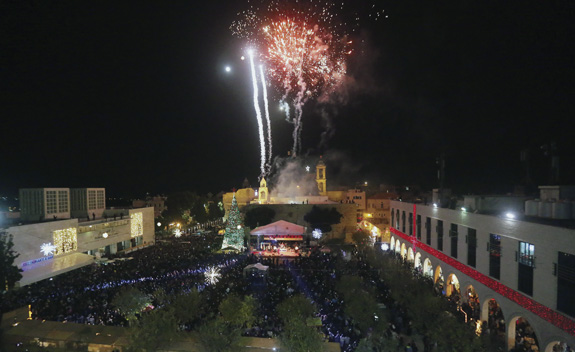By Judith Sudilovsky

BETHLEHEM, West Bank (CNS) – Palestinian hopes for a tourism windfall following Pope Francis’ spring pilgrimage did not pan out because the Gaza war broke out shortly after his visit, Palestinian Tourism Minister Rula Ma’ay’a told journalists.
At the start of the year, the Bethlehem tourism sector had experienced a 19 percent increase in visitors and a 37 percent increase in overnight stays, the minister said in an early December briefing. During the outbreak of the war, there was a 60 percent cancellation rate, she said. It was the first decrease in the number of visitors in the past few years, which have, until now, seen a steady if slight increase, she added.
Overall, however, 2014 ended up with a 9.2 percent increase in visitors, and authorities are expecting 100,000 visitors during December and 10,000-15,000 visitors on Christmas, she said.
“We were very optimistic the pope’s visit would attract many tourists from all over the whole world. We had hoped that when people saw the pope walking around Bethlehem and meeting Palestinians without a problem, it would give a good image of the people here and many would want to come visit,” said Ma’ay’a.
But soon after he left the war broke out, she said. By early December, that had caused a $30 million loss in revenue to the Palestinian economy, she estimated.
“We still hope more tourists will follow in his footsteps,” she said.
This year the highest number of tourists came from Russia, Poland and Italy. The United States came in fourth place in the number of visitors to Bethlehem, but was last in the number of overnight stays, she added.
She noted that the Palestinians do not control their own borders, nor do they have an airport, which impedes their ability to affect the number of tourists who visit Palestinian sites.
There are several points of contention in the tourism sector, including the lack of reciprocity between the number of Israeli and Palestinian tour guides permitted to work across the border, with a disproportionate number of Palestinian guides unable to get permits to accompany groups in Israel. Control of religious and archaeological sites in disputed areas of East Jerusalem and the West Bank also remains a point of contention.
Bethlehem Mayor Vera Baboun noted that in 1948, Christians made up 82 percent of the city population while today, due to emigration and the presence of three refugee camps located within Bethlehem, they are no more than 22 percent of the population.
In recent months, she said, some 40 families have emigrated from Bethlehem.
The city suffers from the highest Palestinian unemployment rate at 25 percent, and the highest poverty rate, with 22 percent of the people living under the poverty line, she said.
Tourism is crucial to the Bethlehem economy, she said, but most visitors to the city move “from bus to bus,” stopping at the Church of the Nativity for less than an hour, with no time spent visiting the actual city.
